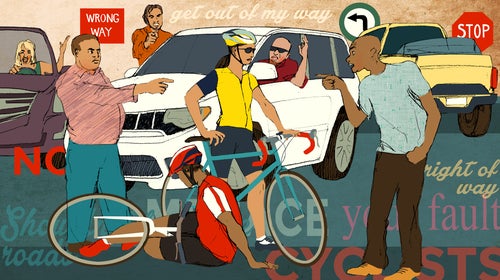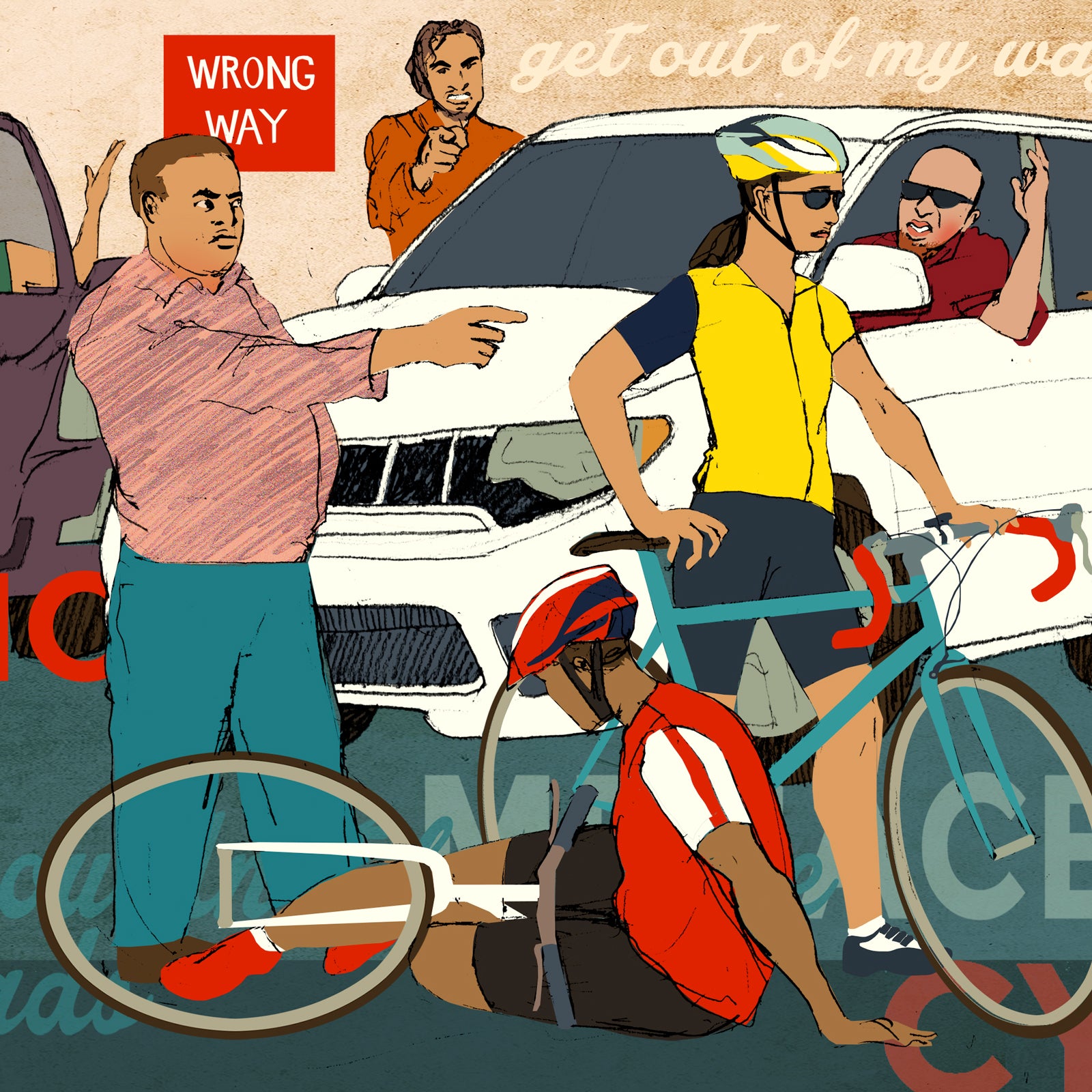Maria “Triny” Willerton was on a final course recon for last year’s Ironman in Boulder, Colorado, when things literally went sideways. It was a sunny, calm weekday morning in early May—“a��perfect day to ride,” she says—and the 46-year-old triathlete was travelling��east on Nelson Road, a straight, treeless��rural route roughly nine miles north of town. After signaling with her arm, she started to turn left onto North 65th Avenue, a quiet stretch of pavement where she would be able to worry less about traffic. She never made it.
Midturn, “I bounced off the grill of a brand-new Ford F-150,” she recalled. “I flew through the air and landed on the westbound shoulder.” that ran later that day in the local newspaper, the Boulder Daily Camera, Willerton made her turn in front of the driver, Stephen Gray, then 62, who was traveling in the same direction and hit her from behind. Willerton never lost consciousness, but she suffered six broken ribs, a triple pelvic fracture, chipped teeth, and a collapsed lung, among other injuries.
It’s an for many cyclists. Hardly a week goes by about a ��in which��a . There is no national-level data on how many cyclists are injured in such��crashes in the U.S., but in 2017��(the last full year for which we have data), on the roads—continuing the upward trend of the past decade. Amid an all-time high of vehicle miles traveled, pedestrian and motorcyclist deaths were also at all-time highs, even as fatalities among car occupants have dropped by more than 30 percent over the last 25 years.
Almost as troubling as the rise in deaths is the media coverage of these crashes. It’s hard to say whether tensions between drivers and cyclists are , or if it just that way because of . News stories often play a key role in shaping public understanding of traffic safety. And when news stories victim-blame or fail to convey the larger context in which these crashes take place, they do deep injustice to the victims and the conversation about road safety in general.
Willerton never lost consciousness, but she suffered six broken ribs, a triple pelvic fracture, chipped teeth, and a collapsed lung, among other injuries.
Two new studies on inaccuracy and subtle bias in mainstream-media reporting about driver-cyclist��crashes highlight the extent of these issues. What they show make clear just how deeply rooted the problem is—and how difficult it will be to fix.
The studies, one from Florida’s Center for Urban Transportation Research and one from a group of researchers from Rutgers, Texas A&M, and Arizona State, are notable in that they used similar methodology to examine different data sets and came up with broadly similar conclusions: journalists are prone to questionable phrasing, and even making flat-out mistakes, when reporting on these crashes. (The��university group’s��research was in the journal Transportation Research Record, and the CUTR research has been accepted for an upcoming issue of the same journal.)
The research examined stories for certain key words indicating whether the cyclist or the driver��was assigned blame for the crash, as well as passive, clinical language that reduced the human role. It also looked at whether the stories framed the crash as a one-off episode or put it in a larger context of road safety.
Passive language was widespread. The university group’s��research examined media reports on 200 crashes nationwide where cyclists or pedestrians died or were seriously injured, and it found that in 80 percent of them, the main actor in the crash was described as a vehicle—not as a person. “Sometimes��the story would say that the person was hit by a car, which is passive,” says Tara Goddard, an assistant professor of urban planning at Texas A&M, who was involved in the study. This language distances the driver’s actions from the crash. “To say an object with no capability on its own actively hit a cyclist is hilarious phraseology,” says Megan Hottman, a Colorado lawyer who represents cyclists hit by drivers.
Many of these stories also still referred to crashes as accidents, despite the rise of the ��traffic-safety-awareness campaign. The CUTR study examined 189 news reports of cyclist fatalities in crashes in Hillsborough County, Florida, over a ten-year period and found that “accident” appeared in 48 of them; another 12 used the word “incident.” In 55 of the stories, no mention was made of a human driver.
“‘Accident’ conveys inevitability,” Goddard says. “You can trace virtually every crash to something upstream, whether human error, poor street design, or something else. Almost every crash is preventable.” Socially, we’re ” that it’s still , such as the Daytona 500.
The studies also looked at whether reports contained what the researchers called a counterfactual: a detail that subtly shifts blame, such as noting that��the victim “was not wearing a helmet” or “was wearing dark clothing.”��In the university group’s��study, 48 percent of the examined stories��included such a statement, which,��without important context, suggested the victim was at least partly at fault. “Dark clothing is irrelevant if the driver is distracted,” says Goddard, “and a helmet will not save you if the driver hits you at 60 miles per hour.”
These counterfactuals don’t just crop up in news stories; they appear in civil court cases, too. “I had a client who was hit at 9 a.m. in June, broad daylight, wearing normal street clothes,” says Hottman. “And the defense made the implication that it was his fault for not dressing in a bright and visible fashion.”
Many of these stories also still referred to crashes as accidents, despite the rise of the��Crash Not Accident��traffic-safety-awareness campaign.
Most news reports about crashes understandably focus on the facts of the crash. But whether those facts are presented in isolation, called episodic framing, or in context of broader traffic-safety themes—like whether a particular intersection is especially prone to fatal crashes—matters in terms of public perception. In the university group’s��research, just 12 of the 200 articles studied used a predominantly thematic framing. Another 16 mentioned the rate of crashes in the area, but none featured comments from the crash victim or road-safety experts like urban planners. When crash stories are presented thematically, says Goddard, people are more likely to call for action to address the issue. The Camera story about Willerton, for instance, noted that a year before she was hit, another driver hit a cyclist at the same intersection. The speed limit in the area was lowered after Willerton’s crash.
The question is why media reports are so often filled with loaded language and narrow framing. Neither study delved into motive, but broad, often subconscious may play a role, according to both research��groups. (We see much of the same thinking today in .) But Willerton’s case points to a deeper problem that was beyond the scope of the two studies: who and what reporters use as sources.
In Willerton's��case, the Boulder Daily Camera reporter, Mitchell Byars, successfully avoided many of the pitfalls of crash reporting. But he got one crucial fact wrong, and why he got it wrong suggests the problem can’t be solved with simple solutions.
Byars has covered crime and the courts for more than 14 years, including a decade at the Camera. “Usually we hear about crashes��one of three ways,” he says: police scanner, police-blotter reports, or witness reports. It’s rare for reporters to respond directly to a crash scene, and��while witnesses are sometimes available after the fact, “a lot of times, initially, we’re relying on those police reports,” Byars says. That’s in large part due to limited staffing. Under private-equity ownership, newspapers in general have seen steep job losses in the last decade (despite ��in many cases), and nowhere have those losses been more keenly felt than at community newspapers. The Camera has; a sister paper, the Longmont Times-Call, has five reporters, for a total of 12 journalists to cover everything from education to courts to breaking news��across a 740-square-mile county that has��a major state university and more than 300,000 residents.
Byars says that, partly because Boulder has such a large cycling community, he may be more aware of problematic terms and phrases like “accident” or “was struck by a car” than reporters elsewhere in the U.S. But, he says, if he’s quoting a police spokesperson��or report, he has to use the terms they choose. And as in the Willerton case, those reports are often from open investigations, which means police aren’t done gathering facts.
The problem in preliminary police reports is what Goddard calls survivor bias. The data the two research groups looked at included many fatal crashes, meaning that, by definition, one party was never able to give a statement. Even in cases where the cyclist survives, they’re often unable to give a statement immediately due to��their injuries. None of the stories Goddard’s team studied about a crash in which��the victim survived included a comment from the victim. While police gather physical evidence from the crash, statements from all involved parties are highly valuable. If only one party’s view is represented, the initial investigation report, which reporters rely on, can be dramatically skewed.��
That’s what happened in Willerton’s case. She spent six days in the hospital after the crash. The day after she was released, an officer came to her house to get a statement.
Stephen Gray claimed that Willerton swerved in front of him in the eastbound lane. But Willerton recalled the moments before the crash differently. “I looked back, and there was absolutely no one behind me, which is unusual on Nelson,” she says. A straight, two-lane road with a roughly four-foot bike lane on the shoulder but no turn lanes, Nelson sees around 5,500 car trips a day. The speed limit at that location was 50 miles per hour (since changed to 35), and there are no trees, buildings, or other objects that would obstruct a driver’s view. As Willerton recalled, after looking behind her, she signaled, moved left into the traffic lane, signaled and looked again, and started her turn when Gray hit her as he tried to pass on the left.
Willerton’s story was supported by physical evidence from the scene. With Willerton’s statement and corroborating evidence, the state patrol cited Gray with careless driving resulting in injury. But that was weeks after the Camera’s initial story reported incorrectly that Willerton had turned into Gray’s path.
It’s impossible to know how often false statements or bias—conscious or otherwise—skew initial police investigations; we only learn about the ones that . In one high-profile case last year in New York City, where a charter bus driver hit and killed a Citi Bike rider named Dan Hanegby, police initially stated that Hanegby, 36 and a father of two, swerved around a parked van, collided with the bus, and fell under its rear wheels—information and other outlets dutifully reported.
The Times noted that Hanegby was wearing headphones��but not a helmet, although no helmet would offer protection against being crushed by a 50,000-pound vehicle. In four days later, Hanegby’s friends and family questioned the police report, citing his experience as a cyclist and surveillance video footage that appeared to contradict the official account.
Hottman, the Colorado lawyer, speaks to law enforcement nationally to educate them on cyclists’ rights. She’s encountered only a few instances of anti-cyclist bias by police investigating crashes. “With few exceptions, cops just want to get it right,” she says. “They see themselves as protectors of their communities, and they show up with open minds and investigate.” But she acknowledges that her experience isn’t universally applicable. There are numerous, troubling instances of anti-cyclist bias by police, as �����ԹϺ��� columnist��Eben Weiss detailed recently, not for the first time. Another , noting��instances of bias and victim-blaming by New York City police.
Even when police are diligent in their jobs, the inherent tension between law enforcement’s need for a careful investigation over time and the media’s interest in reporting breaking news creates problems. Julie Bond, a��CUTR researcher, says that in Florida, her findings indicate that police almost never cite a driver in a crash based on a preliminary investigation (the broad exceptions are DUIs and hit-and-runs). Media stories based on those reports often mention the driver wasn’t charged��but fail to add that the investigation is ongoing, “so people say, ‘Oh, the driver wasn’t cited, so it must have been the cyclist’s fault,’” she says. Even after the investigation wraps up, police can be reluctant to file charges. A recent report from the Bicycle Coalition of Philadelphia looked at every bicyclist, pedestrian, and motorcyclist fatality in 2017 and 2018 in the city—95 deaths in all—and found that in the 51 cases for which data was available, less than a third of the time. The true figure is likely even lower; no data was available in 44 cases.
Even when police are diligent in their jobs, the inherent tension between law enforcement’s need for a careful investigation over time and the media’s interest in reporting breaking news creates problems.
The question is what to do about it. Hottman is stepping up her long-running outreach to law enforcement and district attorneys, particularly in Colorado, and says she’s had success increasing cyclist and pedestrian safety��as a priority for district attorneys in the Denver metro area. Bond and Goddard are both looking into future phases of research on media reporting, as well as exploring curriculum plans to bring reporters and police public-information officers together with transportation professionals and advocacy organizations in a workshop setting to help improve reporting.
Sometimes��the record is corrected. In Hanegby’s death, surveillance video showed he had the right of way. The bus driver forced his way into a narrow street, pinning Hanegby between his bus and a parked van. With this evidence, District Attorney Cyrus Vance charged the driver, Dave Lewis, with failure to yield, a misdemeanor, and failure to exercise due care, a moving violation. He was in October and sentenced to (the maximum allowed under the charges). The Times, among other news outlets, reported on the charges .
In Willerton’s case, because she survived and was able to give a statement, the police investigation report was changed, and Gray was charged with careless driving resulting in injury—a similarly minor infraction. He has pleaded not guilty and will go to trial in June. After police charged Gray, the local website 303Cycling on the charges, as did Byars for the .
Whether justice is served is another matter. District attorneys have a duty to only pursue cases they believe they can prove beyond a reasonable doubt. And they also must balance caseload against finite resources: traffic crashes have to be weighed against cases of assault, robbery, murder, and other serious crimes. Hottman said that a number of the DAs in Colorado, including Boulder’s Michael Dougherty, are taking an increasingly aggressive stance on traffic crashes that injure vulnerable road users, but Hottman��also deals with DAs who simply want to resolve a case and move on, which can mean plea deals that are unsatisfactory to victims, or even dismissals. Even when cases are brought to trial, the need to secure convictions can sometimes mean pursuing a case with lesser charges than victims and advocates feel is warranted.
Willerton, against all odds, recovered in time to race and finish the Ironman World Championships last fall. But she has lingering physical complications. She also sees a therapist for PTSD related to the crash, and she doesn’t ride on open roads anymore. “I’ve been on dirt roads a few times, and even then, I was looking over my shoulder,” she said. She has a fresh appreciation for how inadequate the laws protecting cyclists are��and is starting to speak out more to create empathy for cyclists and, in her words, “put faces to all the bodies out on the road.” And her mind often goes to the connections between her crash and the one that happened at the same intersection exactly one year earlier. On May 8, 2017, a reporter for the Times-Call��quoting police officials that a male cyclist heading east on Nelson Road attempted to make a left turn onto North 65th Avenue and was hit from behind by a Ford Escape.
The driver��was not cited, although she was issued a summons for an invalid (revoked or suspended) driver’s license. Charles Crenshaw, 69, of Niwot, Colorado—an angler, chef, and —died at the scene.


